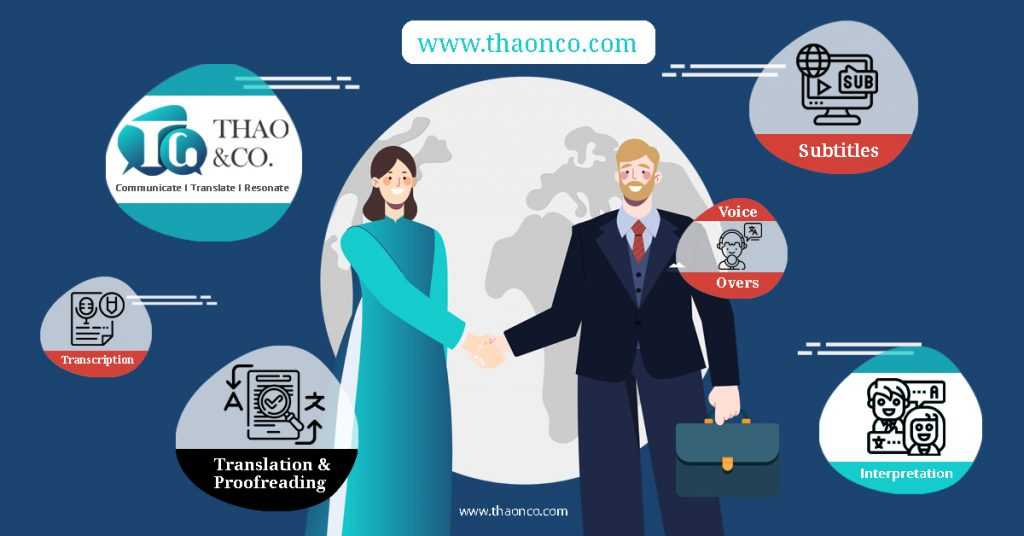Localization is a crucial task if you want to develop content with a global approach. Here are 6 localization best practices from our experience at Thao & Co. to help you streamline this process.
Content Localization is the process that helps your products or content approach global audiences. This process typically includes a series of stages such as translation, proofreading, interface adaptation, integration, and more to make your content accessible to your target audience. Localized content is aligned with the language, content consumption habits, and cultural values of the local audience.
Nowadays, most content needs to be localized to succeed in the international market. Audiences generally love content that resonates with their language, culture, and habits. Typically, these content types need localization to reach audiences in multiple markets: apps, websites, games, software, and more.
See more: App + Software + Website + Game Translation Services
It is advisable to keep in mind the following 6 best practices for a successful content localization project.
It may be helpful for software publishers to consider the following issues. When programming or producing content, pay attention to multilingual capabilities and avoid using hardcoding.
When the content is hard coded into your software, it may be extremely difficult to add new languages. This is a complex issue and may take a considerable amount of time to resolve.
During the programming phase, software developers can use formats such as JSON, ARB, YAML, XLIFF, etc. for content to prevent duplication or code corruption. Localization experts can add new languages seamlessly with these formats.

There are numerous ways to make your content appeal to new audiences. However, it is essential to ensure that the language on your content interface meets your audience’s needs. For an enhanced user experience, it is best to research SEO keywords and industry terms that the locals are using.
Additionally, researching the target audience language can help localization experts provide specific translation guidelines, ensuring consistency throughout the entire localization process.
For example, the word “beef” in English is normally a common type of food. However, when localizing this content into Indian languages, religious considerations should be taken into account. In Hindu culture, the cow is worshipped as a god. The term “beef” would be sensitive and unacceptable in content for Indian audiences.
Before localization, experts need to understand the date, time, and measurement formats, as well as the currency units used in the target language. Different countries have different conventions for these.
Understanding this is a simple task but it can create a significant impact on the audience’s awareness. Therefore, audiences may have an inconvenient experience if the date, time, and measurement formats are different from their local conventions.
For example, Americans use a 12-hour clock format, while Vietnamese use a 24-hour format. When localizing content from American English to Vietnamese, experts may need to consider adjusting the time format as well.

The text length might be different depending on the language. Therefore, the localized content might be shorter or longer than the original. The user interface (UI) design also needs to be adjusted to fit the length of the content.
For example, the English word “login” is translated into Vietnamese as “đăng nhập,” which is noticeably longer. Publishers may consider adjusting the size of buttons containing this keyword to maintain an aesthetically pleasing interface.
The localized content should maintain consistency in terms of images, colors, and brand style. Localization experts should adhere to translation guidelines to preserve these elements.
Ensuring brand consistency between the source and localized content helps enhance the visibility of your content and products in the global market.
Regular testing and evaluating for efficiency are crucial when localizing content. After integrating the new language, technical experts need to conduct thorough product testing to ensure smooth functionality. Additionally, they may also need to observe audience reactions to assess the efficiency of the localized product and adapt accordingly.
At Thao & Co., our team of IT experts is ready to assist you with the integration of localized content. This is an important complementary service for a content localization project. After that, our linguists and tech experts will evaluate the quality of the localized product and its alignment with your preferred language and culture.
Related article: Localization Testing

To achieve high quality in content localization, it is important to understand the 6 best practices mentioned above. These are also the basis for evaluating the efficiency of the software localization. The optimal solution for this task is to collaborate with a professional localization partner with a capable team of linguists.
At Thao & Co., we provide content localization services for apps, software, websites, games, and other types of tech products. We offer a professional localization process and transparent quote. Additionally, our team of linguists has experience in various fields such as legal, healthcare, entertainment, gaming, and more. We are committed to providing the best localized content for your products.
We also offer complementary services including Translation Guidelines, SEO Keyword Research, Customized Integration and Linguistic Review. These services can help businesses save time, enhance quality, and improve the efficiency of the end product.
For more information on content localization, you can visit our website Thaonco.com, or contact us directly on our Get a Quote page for a detailed consultation!